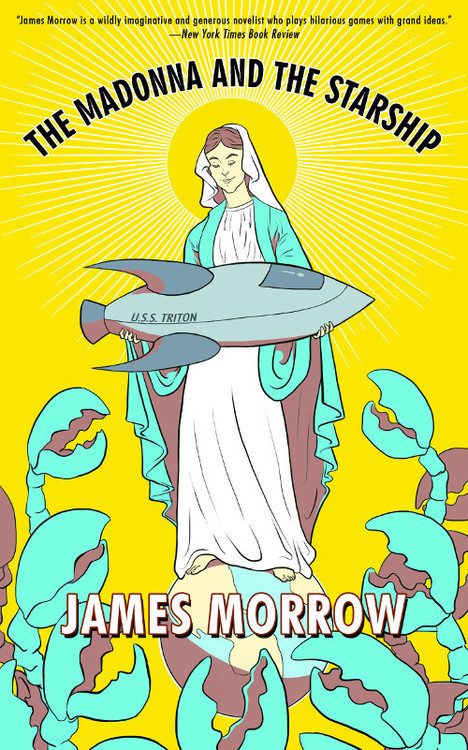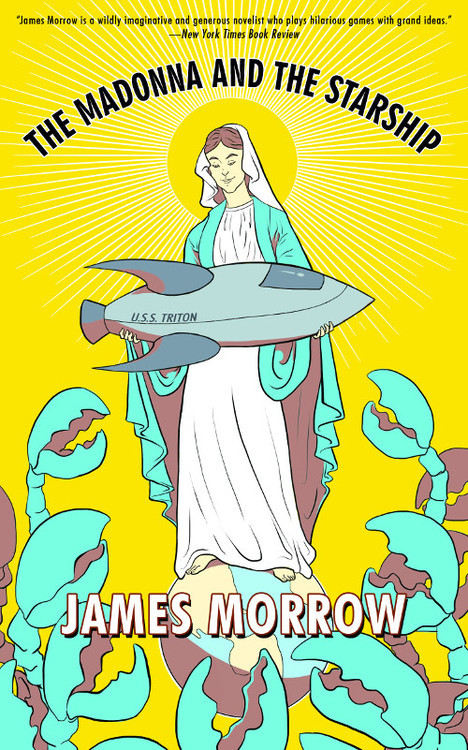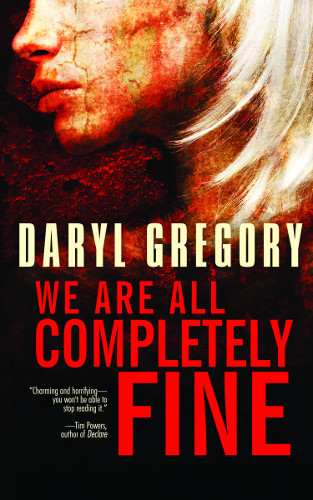Help us welcome Tachyon Publications to the Crawl! They are joining the Crawl for the first time this year! Welcome aboard! We look forward to what they put together.
Tachyon is an independent book publisher that publishes science fiction and fantasy. From Tachyon: A tachyon (tack-ee-on; from the Greek tachus, meaning “speedy”) is a hypothetical elementary subatomic particle that is capable of exceeding the speed of light. Tachyons would violate causality if they were proven to exist, because they could be sent to the past, creating a time paradox (like on every other episode of Star Trek). This is how we meet our deadlines here at Tachyon—first we miss them, and then we go back and meet them. Tachyons actually travel faster when they are losing energy and slow down when they are gaining energy, which is kind of a metaphor for the publishing industry, if you think about it (we try not to).
They have published some amazing books, so make sure you check out their offerings soon!
Tachyon Publications
http://tachyonpublications.com
https://www.facebook.com/pages/Tachyon-Publications/188071218595
the madonna and the starship
THE MADONNA AND THE STARSHIP is a fun read, as a satire novel should be
Alec Checkerfield Uncategorized elizabeth story, genre-bending, humor, James Morrow, parody, review, satire, science fiction, the madonna and the starship

Anton at Genre-Bending decided he needed to read some funny science fiction and focused in on James Morrow’s The Madonna and the Starship.
It’s a delight to read: ‘heartless aliens, promiscuous death rays, casual slaughter — this was science fiction at its worst.’ It mentions all these things, plus it has giant genocidal blue lobsters from outer space. There is, perhaps, too much of what Dirda calls ‘retro-fun’. There are some in-jokes in the book, but I wonder how many people will get them (I certainly didn’t). It’s still a fun read, as a satire novel should be.
Read the rest on Anton’s review at Genre-Bending.
For more on The Madonna and the Starship, visit the Tachyon page.
Cover and design by Elizabeth Story.
The Island of James Morrow celebrates all things Morrow
Alec Checkerfield Uncategorized elizabeth story, James Morrow, parody, patryk soika, satire, science fiction, the island of james morrow, the madonna and the starship, web site

The Island of James Morrow, the freshly renovated Internet home for the award winning author of The Madonna and The Starship, recently premiered under a new URL and with new content. Largely the work of webmaster Patryk Soika, the site celebrates all things Morrow including information on his works, passions, and more.
To learn more about James Morrow, check out The Island of James Morrow.

For more on The Madonna and the Starship, visit the Tachyon page.
The Madonna and the Starship cover and design by Elizabeth Story.
THE MADONNA AND THE STARSHIP is about the most fun you can have in a philosophical novel, with or without big blue lobsters.
Alec Checkerfield Uncategorized afterparty, bradley w. schenck, daryl gregory, elizabeth story, henry kuttner, James Morrow, review, the madonna and the starship, we are all completely fine, webomator

At Webomator, Bradley W. Schenck reviews James Morrow’s The Madonna and the Starship in context of the recent Locus roundtable conversation between Morrow and Daryl Gregory, author of Afterparty and We Are All Completely Fine.
I’m very fond of Henry Kuttner’s humorous stories. The Madonna and the Starship is the closest thing I’ve ever seen to a modern work in the vein of Kuttner’s Gallegher or Hogben stories: Morrow gives us bizarre aliens with bizarre intentions, and frenzied protagonists who have to find a way to deal with them. The book is straight out of Kuttner’s era, too, since it’s set in the live television studios of the 1950′s. It is about the most fun you can have in a philosophical novel, with or without big blue lobsters.
And that’s really what it is: a story about warring philosophies. If “warring” sounds like an exaggeration, I have two words for you: death rays.
Read the rest of Schenck’s article (which also includes a review of Afterparty) at Webomator.

For more on The Madonna and the Starship, visit the Tachyon page.
Cover and design by Elizabeth Story.
THE MADONNA AND THE STARSHIP is sure to be good
Alec Checkerfield Uncategorized andrew wollman, elizabeth story, humor, James Morrow, parody, prepopculture, satire, science fiction, the madonna and the starship, vroman's

Andrew Wollman on episode 98 of the PrePopCulture podcast recommends James Morrow’s The Madonna and the Starship, but sadly can’t review it yet because his local bookstore (Vroman’s in Pasadena, CA) didn’t have it.
His commentary about the book begins at 53:31, but you really should listen to the whole exciting podcast.
For more on The Madonna and the Starship, visit the Tachyon page.
Cover and design by Elizabeth Story.
THE MADONNA AND THE STARSHIP is fun
Alec Checkerfield Uncategorized critical mass, Don D'Ammassa, elizabeth story, humor, James Morrow, parody, review, satire, science fiction, the madonna and the starship

For Critical Mass, Don D’Ammassa reviews James Morrow’s The Madonna and the Starship.
A lowly hack television writer who doubts he will ever accomplish anything gets the surprise of his life when aliens turn up and tell him that they’ve been intercepting our broadcasts and consider his work high art. Much to his chagrin, they have trouble separating fact from fiction and reason from faith and much to his horror they intend to helpfully eliminate a few million people they think are just cluttering up the Earth. So our hero has to sharpen his wits to talk them out of it. This is humor, obviously, with more than a touch of satire. It’s not quite as ambitious as some of Morrow’s earlier work, but it’s likely to have a somewhat broader appeal. And it’s fun.
For more on The Madonna and the Starship, visit the Tachyon page.
Cover and design by Elizabeth Story.
THE MADONNA AND THE STARSHIP is reminiscent of Sagan’s The Demon-Haunted World but funny
Alec Checkerfield Uncategorized carl sagan, duncan lunan, elizabeth story, humor, interzone, James Morrow, parody, review, richard dawkins, satire, science fiction, the madonna and the starship

For the July (253) issue of Interzone, Duncan Lunan examines James Morrow’s The Madonna and The Starship.
“Even the grottiest pulp SF performs a salutary cultural function,” writes Morrow in his afterword. His characters do take their young audience seriously, to the extent that each episode is followed by a short science lesson from ‘Uncle Wonder’, urging their child star and their viewers to try experiments at home, always ending with the mantra ‘Safety first!’ In consequence they are visited by a delegation of Qualimosians – “by-God extraterrestrials, complete with crustacean physiognomy, insectile eyes and an antisocial agenda.” They’ve come to present the show with an award for its values, but also to wipe out irrationality wherever they find it, especially in religious belief.
<snip>
Its central character is Kurt Jastrow, sharing his first name with you-know-who but his last name with a distinguished astronomer and science writer, the author of Red Giants and White Dwarfs (“a masterpiece of science” according to Wernher von Braun), Until the Sun Dies and The Enchanted Loom. Paddy Chayefsky called him “the greatest writer on science alive today” and Sir Bernard Lovell said of him “Very few scientists are capable of writing as fearlessly and honestly as Dr Jastrow”. Calling the character ‘Sagan’ would have been too obvious…but to whatever extent the Qualimosians represent the spirit of Richard Dawkins’ The God Delusion, the ‘live and let live’ moral of The Madonna and the Starship is closer to Sagan’s The Demon-Haunted World. And what’s more, it’s funny!
Read the rest of Hunter’s review in the latest issue of Interzone.
For more on The Madonna and the Starship, visit the Tachyon page.
Cover and design by Elizabeth Story.
James Morrow applied the Page 69 Test to THE MADONNA AND THE STARSHIP
Alec Checkerfield Uncategorized elizabeth story, humor, James Morrow, page 69 test, parody, satire, science fiction, the madonna and the starship

For The Page 69 Test, Marshal Zeringue reports that James Morrow applied the Test to The Madonna and the Starship. Here are some of his findings:
So I cracked the spine, turned to page 69, overlooked the fellationic connotations, and found what amounts to a summary of the plot. This pleased me. The Madonna and the Starship is a pretty complex machine, with lots of moving parts, and I’m glad I decided to periodically recapitulate the basic situation (while trying to avoid schematic exposition). You want to make the reader’s job as easy as possible.
<snip>
My favorite line here is Lenny’s naïve remark, “I never imagined they’d be so antagonistic to God.” But I’m chagrined to recall that I never got around to researching whether there was a Rexall drugstore anywhere near Rockefeller Center in 1953.
Read the rest of Morrow’s discoveries at The Page 69 Test.
For more on The Madonna and the Starship, visit the Tachyon page.
Cover and design by Elizabeth Story.
Daryl Gregory and James Morrow on cinéma du sang, pop culture, PTSD, and the absurd
Alec Checkerfield Uncategorized absurd, cinéma du sang, conversation, daryl gregory, elizabeth story, horror, humor, interview, James Morrow, Locus, locus roundtable, parody, pop culture, ptsd, satire, science fiction, state college pa, the madonna and the starship, we are all completely fine

Locus hosted a roundtable conversation between good friends and State College, PA denizens Daryl Gregory, author of We Are All Completely Fine, and James Morrow, most recently of The Madonna and The Starship fame. The extraordinary duo discuss not only their recent works but the newly minted cinéma du sang, pop culture, PTSD, and many absurd points in-between.
Daryl Gregory: We’re having this conversation by email, but I’m going to pretend we’re sitting in a bar. Even though we live in the same town, and not even a very big one—that’s State College, Pennsylvania, for you readers—I think we see each other more often in other cities, at cons. Is that sad, or just typically science fictional?
James Morrow: I think it’s both sad and science fictional. Writers live in their heads, don’t they?
D: My head has terrible table service. We did finally get together at our local brewpub a couple months ago to talk about free will and consciousness. That was a lot of fun, and was exactly the kind of conversation I used to imagine that science fiction writers had all the time, before I met some and realized we mostly talk about agents and publishers.
So when Alvaro said he’d give us space to talk on the Roundtable, I first thought that we could continue that conversation. But then I finished your new stand-alone novella, The Madonna and the Starship, that’s out now from Tachyon. My own novella, We Are All Completely Fine, is coming out in August. They’re really different books, but I thought we could talk about how both of them use pop culture as a main ingredient.
J: Good idea. But maybe we can sneak in some stuff about free will and its alleged sovereignty.
Read the rest of the fascinating conversation at Locus.

For more on The Madonna and the Starship, visit the Tachyon page.
For more on We Are All Completely Fine, visit the Tachyon page.
Covers and design by Elizabeth Story.
A mixture of breezy humor and provocative thinking characterizes James Morrow’s two most recent sci-fi novellas
Alec Checkerfield Uncategorized humor, James Morrow, michael dirda, parody, review, satire, science fiction, shambling towards hiroshima, the madonna and the starship, washington post

For The Washington Post, Michael Dirda reviews James Morrow’s two most recent books from Tachyon Publications: Shambling Towards Hiroshima and The Madonna and The Starship.
A comparable mixture of breezy humor and provocative thinking characterizes James Morrow’s two most recent sci-fi novellas from Tachyon Publications, “Shambling Towards Hiroshima” (2009) and this year’s “The Madonna and the Starship.” Set in 1945, “Shambling Towards Hiroshima” reveals the secret of the hush-hush Project Knickerbocker: To bring World War II to an end, the U.S. Navy inveigles a Hollywood actor — the star of “Corpuscula” — to don a lizard suit, then films him breathing fire and stomping with rage on a miniature city. Obviously, the Japanese will be shocked into surrendering once they see what will happen to their country if the monster Gorgantis is really unleashed. Nothing quite works out as planned, but Morrow has a lot of fun evoking the 1940s film industry. “What Rough Beast” is even directed by James Whale, the man who gave us the 1931 “Frankenstein.”
In “The Madonna and the Starship,” Morrow turns to the so-called golden days of television. Kurt Jastrow — a name that evokes both Kurt Vonnegut and science popularizer Robert Jastrow — is the head writer for “Brock Barton and His Rocket Rangers.” Each week he generates three-part serials with titles like “The Phantom Asteroid,” featuring Brock and his “fearless first lieutenant, Lance Rawlings; his prepossessing second lieutenant, Wendy Evans, a.k.a. the love interest; a slap-happy ensign, Ducky Malloy; a humanoid robot, Cotter Pin; and a talking gorilla, Sylvester Simian, whose intellect has been augmented through accelerated evolution.”
<snip>
Amid all this retro-fun, Morrow soon starts to complicate the picture. One afternoon, Kurt’s Motorola television unexpectedly turns itself on, then displays the fuzzy image of “a svelte blue lobster with serrated claws and a grasshopper’s rear legs. Its visual system was tripartite — three large eyeballs protruded from its brow on pliant stalks — and its toothless mouth opened and closed along the vertical axis.” The creature naturally speaks the immortal line: “Greetings, Earthling!”
<snip>
As it happens, James Morrow is not just an award-winning science fiction writer, he is also a committed atheist. Ever since “Towing Jehovah” (1994), his books have addressed questions of morality, epistemology and religious belief, and done so with a satirical bite. But can the massacre of true believers, even in the name of reason, ever be reasonable? This is, after all, just a comic novella set in an alternate 1950s — nothing to do with the real world.
Read the rest of Dirda’s review at The Washington Post.

For more on The Madonna and the Starship, visit the Tachyon page.
Cover and design by Elizabeth Story.
For more info on Shambling Towards Hiroshima, visit the Tachyon page.
Cover by Ann Monn.
